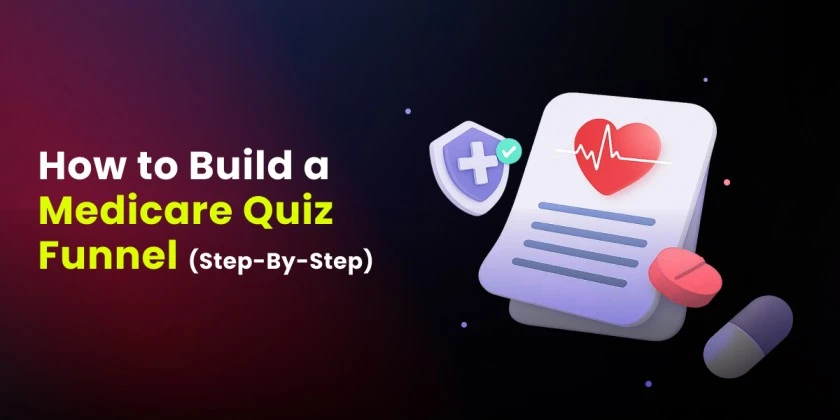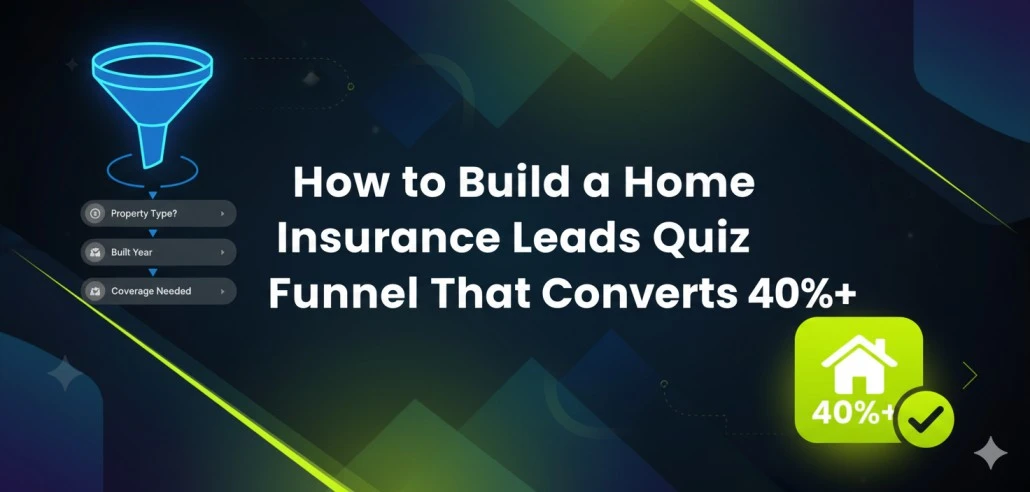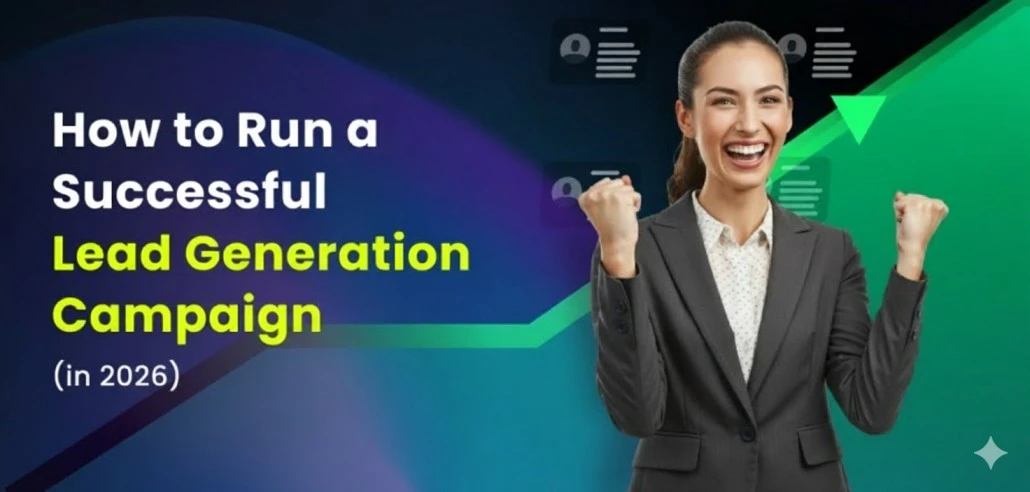Knowing which potential customers to focus on isn’t just helpful—it’s essential for sales success. Lead qualification (the process of determining which potential customers are most likely to buy) helps sales teams avoid wasting time on unlikely buyers and instead focus on promising opportunities.
This guide on how to qualify leads offers a straightforward, seven-step approach that can change how you evaluate potential customers. We won’t cover abstract concepts. Instead, we’ll share practical strategies that companies actually use to improve their results.
These methods work for businesses of all sizes. Small companies can make every sales conversation count. Larger organizations can grow more efficiently. Our framework helps you spot your best prospects so you can close more sales with less effort.
Are you tired of pursuing leads that go nowhere? Would you like to have more productive sales discussions? Let’s explore how to make that happen.
📌 Key Takeaways:
- Lead quality can make or break your sales campaigns, which is why lead qualification efforts should be part of your sales process strategy.
- Qualifying leads takes only 7 main steps.
- A quick lead qualification checklist to get started with your process:
- The ideal customer profile (ICP);
- A lead scoring system; and
- The qualifying questions.
- From these key elements, you move on to the implementation and optimization processes.
Jump to Section:
Why is Lead Qualification Important?
Picture this: Your marketing efforts are bringing in dozens, maybe hundreds, of leads every month. Your freebie lead capture pages are overflowing with signups, your CRM is bursting with names, and yet… your sales team is struggling to hit their targets. Sound familiar?
You see, the lead generation process is a funnel because it filters out the leads that go through it. According to research, less than half of the “qualified” leads your marketing team is so excited about are realistically going to become customers.
MarketingSherpa found that only 39% of firms consistently apply lead qualification criteria, resulting in around 55% of leads being neglected.
In other words, half of your leads get lost in the whirlwind of the sales pipeline and are wasted because you aren’t equipped to qualify leads.
Lastly, of your marketing-generated leads, only 25% are typically of high enough quality to advance directly to sales.
That’s a relatively low chance of converting one lead into a customer, and it likely results in a higher acquisition cost.
While lead qualification is often associated with B2Bs (business-to-business) because of their longer sales process, B2Cs (business-to-customer) should also have strategies for qualifying sales leads.
The lead qualification process is the third step in running a successful lead generation campaign.
It’s what identifies where most of your resources should be directed.
It’s not enough that you generate leads; it’s crucial that you get high-quality leads. If you’re on the fence about building a sales qualification process, here are the top reasons why you need it as a business:
- Maximizes available resources
- Accelerates the sales cycle
- Dramatically improves conversion rates
- Enhances ROI forecasting
- Reduces customer churn
- Provides actionable data
Start Building Your Landing Page Today
Launch high-converting pages in minutes with LanderLab—no coding required.
The Different Types of Qualified Leads
Before taking the steps to qualify leads, let’s first examine the five types of qualified leads based on where they are in the customer journey.
It’s important to learn what these are since we’ll be using them in the lead qualification process later.
1. Information-Qualified Leads (IQLs)
Information Qualified Leads discover your business while actively searching for solutions to their problems. These potential leads find your content helpful and may continue to engage with additional resources.
This early stage presents an opportunity for marketing teams to assess whether these prospects align with their Ideal Customer Profile (ICP) and are up for further nurturing.
2. Marketing-Qualified Leads (MQLs) and Opportunity Qualified Leads (OQL)
Marketing Qualified Leads have a heightened interest in your products or services. They may have downloaded your freebies, signed up for newsletters, or engaged in other mid-funnel activities.
Opportunity Qualified Leads are those already considering you as an option. We’ve lumped them together as some leads become classified as MQL while other are OQL, but they both move to the next stage all the same.
These leads are ready to take more action and commit to the buying process. Ideally, they already align with your ICP and are being nurtured for the next stage of the customer’s journey.
3. Product-Qualified Leads (PQL) and Service Qualified Leads (SvQL)
These leads have directly experienced your product or expressed specific interest in your services. Product Qualified Leads might have participated in free trials, attended webinars, or are comparing products and services.
Service Qualified Leads are those who have shown interest based on engagement with cross-sells, upsells, etc.
We’ve lumped these two together since these leads can pass through one but not the other.
4. Sales Accepted Leads (SALs)
A Sales Accepted Lead (SAL) is an MQL that has been reviewed, evaluated, and formally accepted by the sales team for further qualification and nurturing.
It represents a critical handoff point between marketing and sales departments in the lead management process. They are primed for sales pitches and are typically approaching the decision phase of their buying journey.
5. Sales Qualified Leads (SQLs)
These are your most qualified leads and the most worth pursuing. They have expressed specific interest in your sales offers, often through consultation requests or detailed inquiries for more information.
SQLs are at the bottom of the sales funnel, have adequate purchasing authority, and operate within a timeframe.
Note: There are other types of leads based on different criteria. The ones we presented above are those being used for qualifying leads. To enhance your marketing strategies, learn more about the other types of leads here.
Qualifying Sales Leads: The 7-Step Lead Qualification Process
Your lead qualification process doesn’t have to be complicated. More often than not, it’s as simple as it gets. We will outline a practical, seven-step approach to get high-quality leads. Keep your lead generation strategy in mind as we walk through each step:
Step 1: Create or Refine Your Ideal Customer Profile
Every effective qualification process begins with a clear picture of who you’re actually trying to sell to. Think of it as the “true north” that guides the qualification efforts of marketing teams.
Analyze your current customer base, particularly those with the highest satisfaction rates and the lowest churn rates. What patterns emerge?
Beyond basic demographics, what are their unique pain points, buying behaviors, and decision-making structures?
For B2B companies, this means documenting key details such as company size, industry, typical budget ranges, and organizational structure. Simply put, what kind of company do you want to work with? That’s your ICP.
ICPs are the key to identifying your buyer persona. Who are the decision makers of this company? What are they like? How do you build customer relationships with each person?
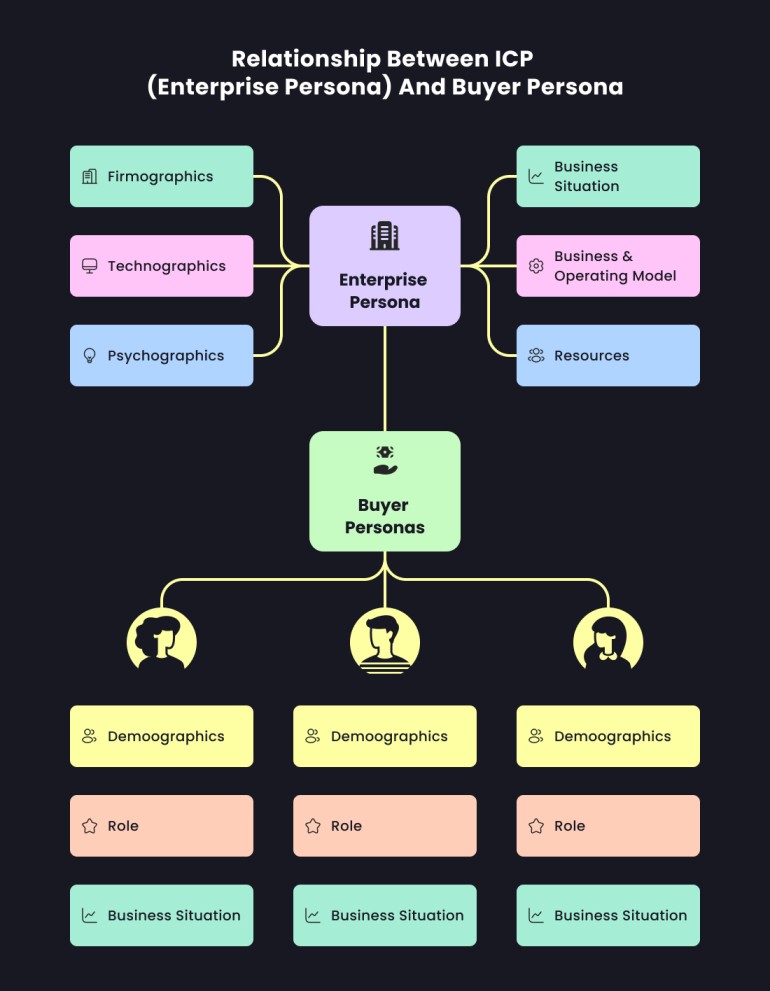
For B2C, this approach is more individualized, so brands typically only have a buyer persona, which involves examining lifestyle factors, purchasing power, and behavioral triggers.
Remember that your ICP isn’t set in stone. Markets evolve, your product changes, and customer needs shift over time. It also doesn’t have to be just one. Multiple ICPs can help you segment as needed to qualify leads effectively.
Schedule quarterly reviews of your ICP, incorporating input from sales, marketing, and customer success teams, to ensure accuracy. The more precise your ICP, the more effectively you’ll identify promising leads and avoid wasting resources.
Step 2: Develop Your Lead Scoring Process & Criteria (Framework)
With your ICPs established, it’s time to create a systematic way to evaluate how closely each lead matches this ideal profile. Lead scoring is the objective framework that transforms subjective impressions into actionable data.
Lead Scoring
Lead scoring assigns numerical values to leads based on specific criteria, such as demographic information, online behavior, and engagement level.
Lead scores can rank your leads based on their perceived value, how closely they match your target audience, or readiness to purchase.
Here’s an example of how you can score leads based on demographics, firmographics, behavior, and negative scoring.
Demographic/Firmographic Scoring (0-50 points)
Company Size
Industry Fit
Target Role
Behavioral Scoring (0-50 points)
Website Engagement
Email Engagement
Event/Webinar Participation
Form Submissions
Social Media Engagement
Negative Scoring
Sample Scoring Scenario
Company: Mid-sized financial services firm
Contact: Director of Operations
Activity: Visited pricing page, downloaded whitepaper, attended webinar, opened 5 emails
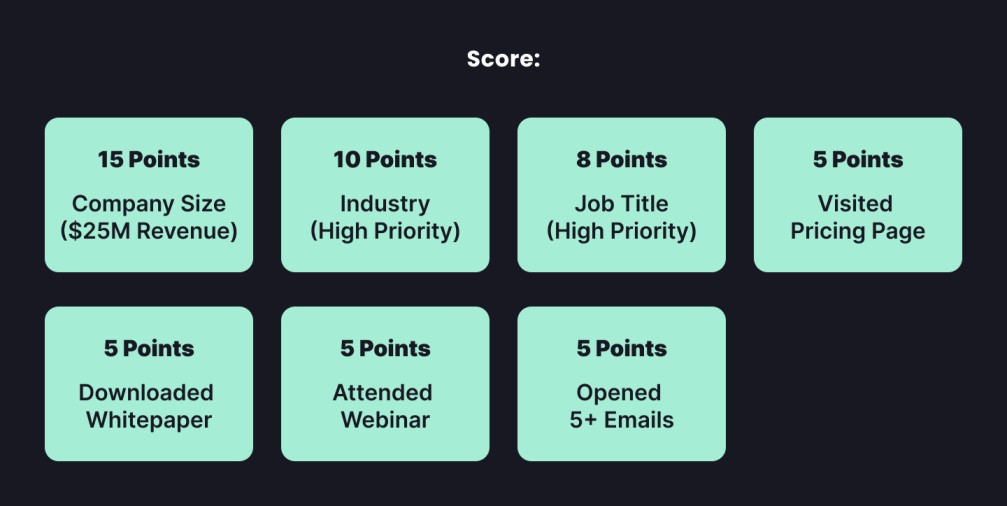
5 Lead Qualification Frameworks Matrix
Lead qualification frameworks are structured methodologies that help sales and marketing teams evaluate whether prospects are likely to become customers. You score a lead’s value based on these qualification criteria.
Here are five common qualification frameworks that you can use to qualify leads effectively.
You will need these when establishing your lead scoring process and creating qualification questions.
Begin by identifying the key attributes and behaviors that correlate with successful conversions. Then, assign point values to each characteristic based on its importance. This will be your lead scoring criteria.
The beauty of a well-designed scoring system lies in its ability to quantify both interest and fit simultaneously.
A prospect might show high engagement (opening every email) but poor fit (wrong industry), or vice versa. Your scoring should reflect both dimensions to create a comprehensive picture of each lead’s potential.
Once your scoring system is established, set clear thresholds that trigger different actions. For instance, in a scoring system of 1-100, leads scoring above 80 points may be directed to sales, while those scoring between 50 and 79 points receive additional nurturing.
Just like your ICP, your scoring system should evolve based on performance data and changing market conditions.
Step 3: Ask Strategic Lead Qualification Questions
Craft your questions around the criteria of your chosen lead qualification framework. However, this still depends on whether you’re qualifying new or nurtured leads.
IQLs and MQLs are more likely to respond to quick questions, while questioning PQL and SALs should be able to reveal deeper insights.
Of course, how you deliver these questions is equally important. So, how do you deliver these to your leads?
Different media offer varying levels of engagement, response rates, and data quality. It also depends on what stage of the sales funnel they are in. Here are examples on how to deliver qualifying questions to your audience:
Landing Pages and Lead Forms
Include strategic qualification questions on forms that prospects complete when downloading content, requesting information, or signing up for services.
Web forms are excellent for initial qualification at scale, especially for inbound leads who are already showing interest by visiting your site. Landerlab makes it easy to build these and qualify leads.
Qualifying leads using landing pages can look as simple as this:
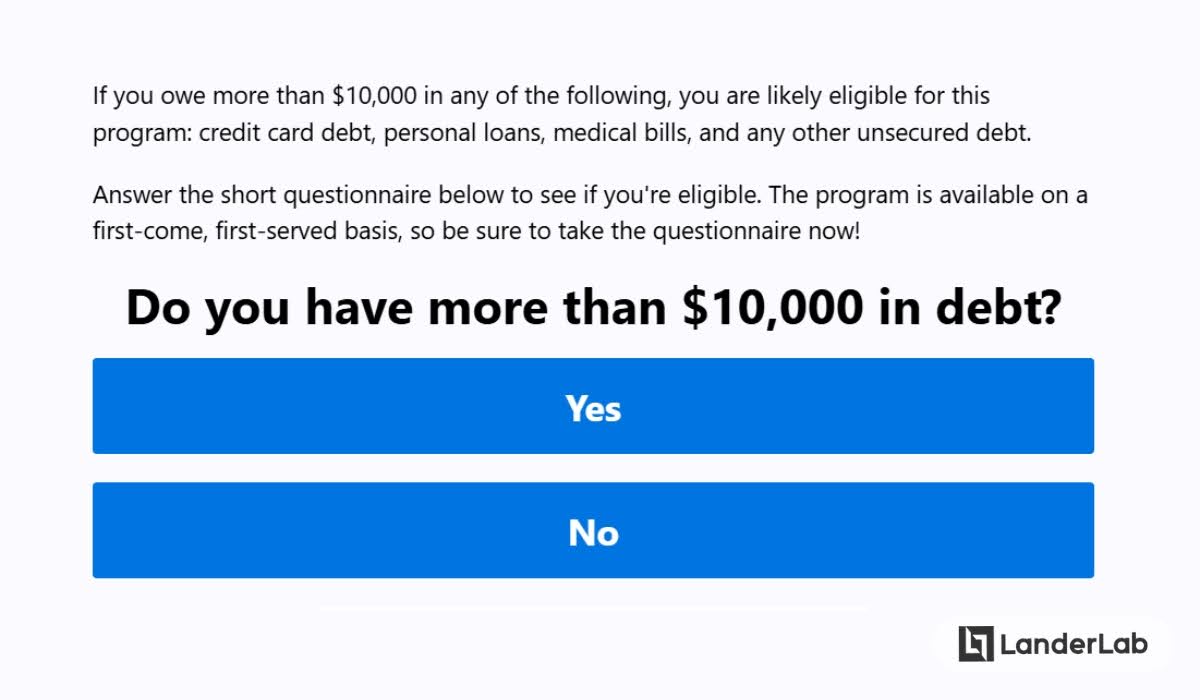
Or it can have long lead forms like this:
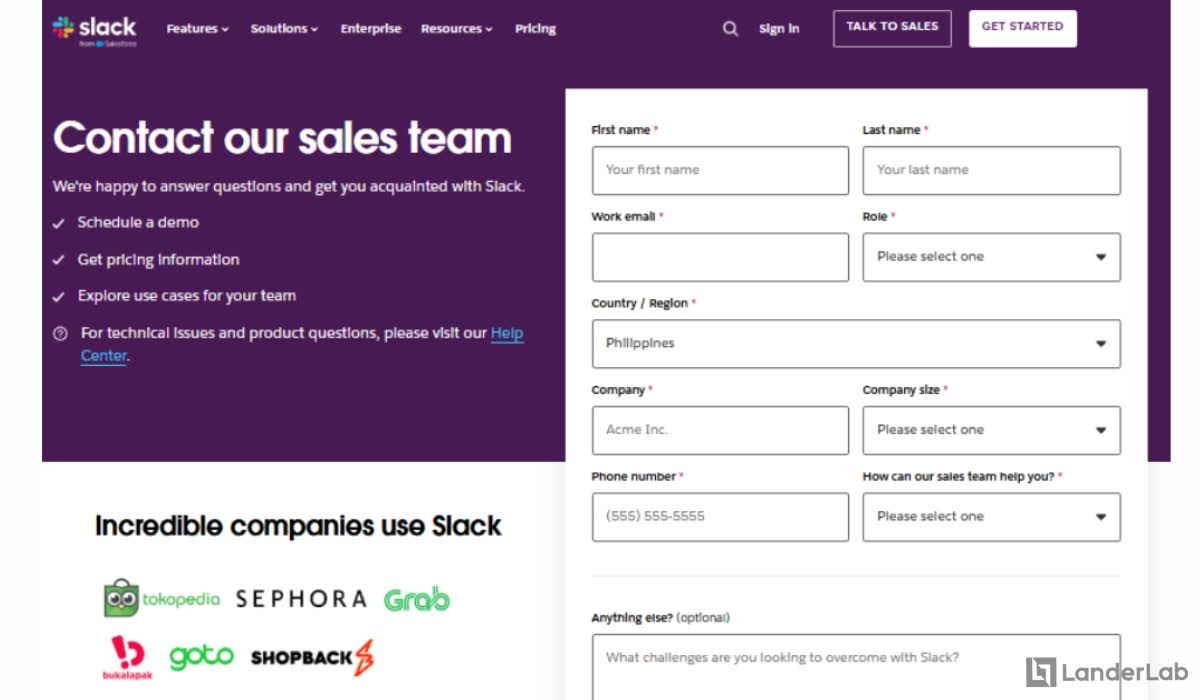
Social Media Channels
Everyone’s on some kind of social media channel. Use these social platforms to qualify leads through polls and interactive posts casually. Social media qualification works well for building relationships with prospects early in their buyer’s journey.
Email Surveys
Send focused questionnaires to leads who have already engaged with your company. Email surveys are most effective for nurturing leads who have shown initial interest but require further qualification before a sales engagement. Here’s a good example of how to do it (the way BookBub did):
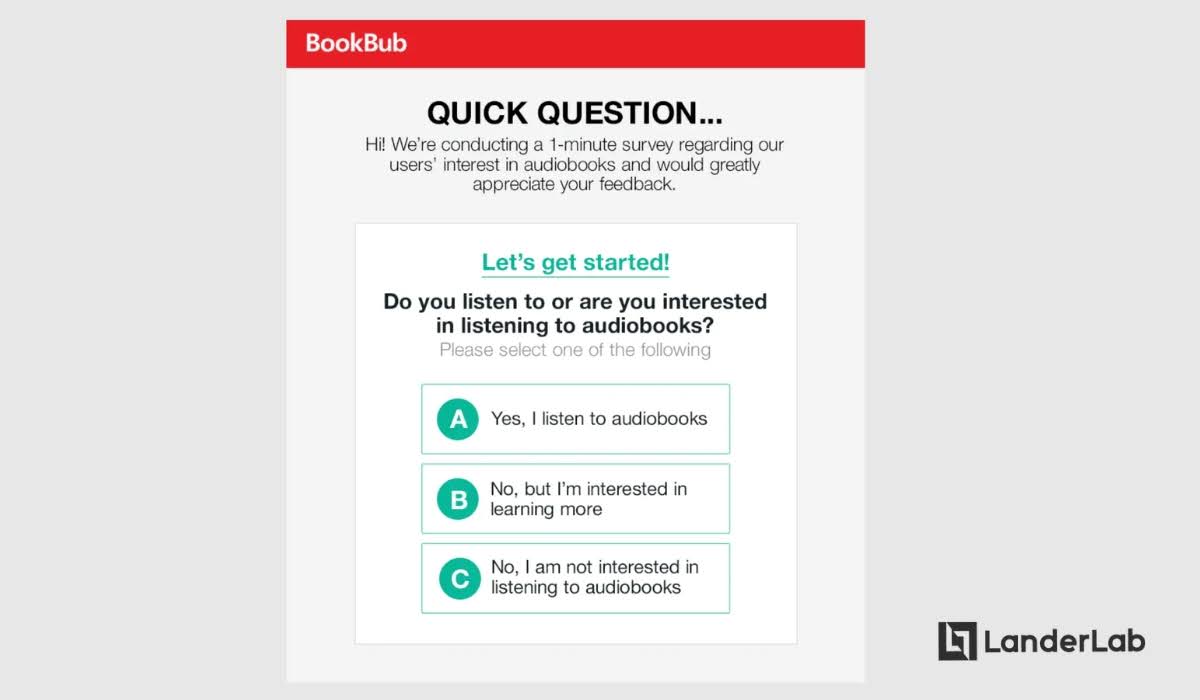
Live Chat and Chatbots
Implement conversational qualification through website chat functionality, either with live agents or AI-powered chatbots, like ManyChat or ActiveCampaign.
This can be used in combination with social media channels where you get direct messages. Chat is ideal for real-time qualification when prospects are actively exploring your website and have immediate questions.
Here’s a lead scoring system that can be implemented in ManyChat:
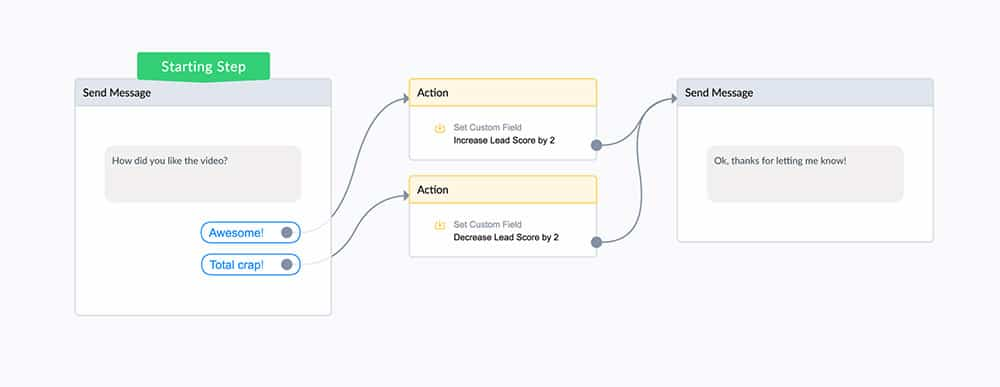
Sales Discovery Calls & Video Meetings
Schedule dedicated calls or video meetings where sales representatives can qualify prospects through in-depth conversations and discussions. These are best suited for high-value prospects who have demonstrated significant interest and warrant personalized attention.
Live or Evergreen Webinars
Host interactive online presentations where you can engage with prospects in real-time through polls, Q&A sessions, and chat features. Live webinars excel at qualifying multiple prospects simultaneously while providing educational value. They are particularly effective for B2B companies with complex solutions and demonstrations.
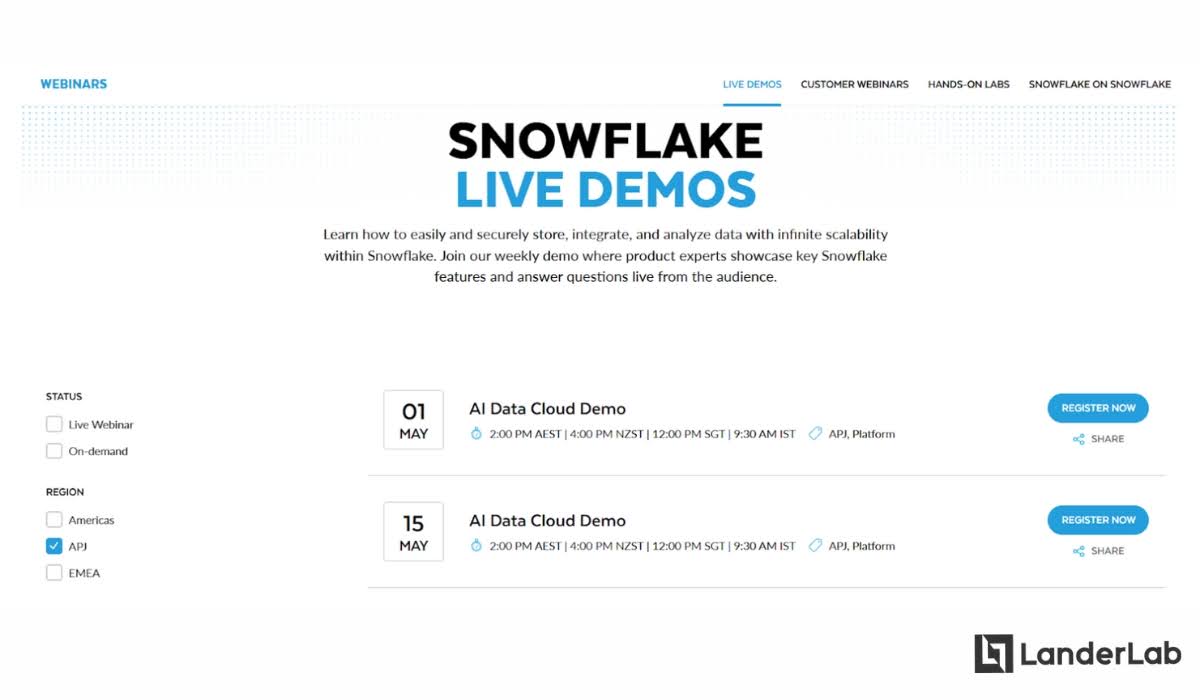
In-Person Evenets
Use trade shows, conferences, and networking events to qualify prospects through face-to-face conversations. In-person qualification is particularly suitable for industries where personal relationships significantly influence buying decisions, such as enterprises and large corporations.
Automated Phone Systems (IVR)
Pretty sure you’ve heard this script: “Thank you for calling. For customer information, press 1. For sales, press 2…“. Notice how they qualified the inbound call? Voice response systems are most effective for high-volume inbound call centers that require preliminary routing.
Make it creative! Qualifying questions should engage your prospects and encourage them to respond. It should flow naturally and not feel like an interrogation.
The information gathered here will not only help you qualify the lead but also personalize your approach if they move forward in the sales process.
Step 4: Implement the Qualification Process
With your framework established, it’s time to put your lead qualification system in operation!
The key to successful implementation is clarity and consistency, ensuring a seamless handoff between marketing and sales teams.
Do this with a detailed Standard Operating Procedure (SOP), documenting the exact workflow that leads will follow —from initial capture through qualification stages and into the sales process.
- Define precisely when a lead transitions from Marketing Qualified to Sales Qualified status, including the exact criteria and required actions at each stage.
- Train all team members thoroughly on both the conceptual framework and the practical mechanics of your qualification process. Sales and marketing teams should have a shared understanding of qualification criteria to prevent the all-too-common scenario where marketing celebrates “qualified” leads that sales considers worthless.
- Consider implementing service-level agreements (SLAs) that establish expectations for response times, data collection responsibilities, and follow-up protocols. For example, sales might commit to contacting all newly qualified leads within 24 hours, while marketing agrees to provide complete qualification data with every handoff.
The most effective qualification processes balance human judgment with automation. Use technology to handle repeatable aspects, such as initial scoring and delivering qualifying questions, while relying on experienced team members for final qualification decisions that require a nuanced understanding of your campaign goals.
Step 5: Research and Enrich Lead Data
Even the most candid prospects won’t tell you everything you need to know, which is why proactive research is a critical component of thorough lead qualification. Think of this step as filling in the blanks that remain after initial contact.
Begin by examining:
- The prospect’s company website and social media presence to gain insight into their positioning, recent announcements, and organizational structure
- LinkedIn profiles for valuable insights into the backgrounds, tenure, and networks of decision-makers
- Industry publications that might reveal competitive challenges or market positioning that impact their needs
Modern lead enrichment tools can dramatically accelerate this process by automatically appending data about company size, technology stack, funding rounds, and growth trajectory.
CRM systems can track digital engagement patterns across your website and content, revealing areas of interest that you might not have discovered through direct questioning.
The goal isn’t to become a stalker but rather to develop a comprehensive understanding of the prospect’s situation before investing significant sales resources.
Step 6: Recognize Disqualification Signals
Qualification and disqualification are two sides of the same coin. Knowing when to walk away from a prospect is just as important as identifying promising opportunities. Clear disqualification criteria protect your most valuable resource—your sales team’s time.
Train your team to identify the warning signs of unqualified leads.

Create a formal process for disqualification that includes documentation of the specific reasons. This data is crucial for early screening processes and lead retargeting.
When appropriate, establish nurture paths for disqualified leads who might become viable in the future when circumstances change (a.k.a. Recycled Leads).
Disqualification isn’t a failure. The ability to quickly disqualify inappropriate leads is often what allows top-performing sales teams to focus their energy where it matters most, on more successful lead conversions.
Step 7: Analyze, Learn, and Optimize
Like any other marketing campaign, lead qualification is never truly finished—it’s an evolving system that should be continuously data-driven.
Implementing a rigorous analysis and optimization loop ensures your qualification approach is robust against changing markets and customer needs.
Track key performance metrics that reveal qualification effectiveness:
- What percentage of “qualified” leads convert to opportunities? To closed deals?
- How do lead conversion rates vary based on source, medium, or qualification score?
- What’s the average sales cycle length for leads that enter your sales pipeline through different qualification paths?
Compare leads that were initially qualified similarly but had different outcomes. What subtle factors might explain why some converted while others didn’t? This analysis often reveals new qualification criteria you should incorporate or existing factors that deserve different weightings in your scoring system.
Also, evaluate your leads based on the key performance indicators (KPIs) you set initially.
Furthermore, don’t forget to gather feedback from your sales team about the quality of leads they’re receiving. They’re on the front lines and often notice patterns before they appear in your data. Similarly, win/loss analysis from closed deals can reveal qualification blind spots or emerging sales opportunities.
Make optimization a scheduled activity rather than an ad-hoc reaction to problems. Quarterly reviews of qualification effectiveness, combined with optimization initiatives, ensure your process evolves alongside your business and market.
Example Scenarios for Qualifying Leads
The steps are simple, but they can get daunting. So here are some scenarios to help you get started in your lead qualification efforts:
Example #1: B2B Software Company Qualifies IQL to MQL
Consider TechSaaS Inc, a B2B software company that develops project management software for small to medium-sized businesses.
Their lead capture starts with valuable content addressing common project management challenges. They publish blog posts, infographics, and free templates that attract potential customers searching for solutions to their organizational problems.
When Sarah, an operations manager at a growing e-commerce company, searches for “how to improve team productivity,” she finds TechSaaS’s comprehensive guide. Sarah has shown basic interest but doesn’t really need anything else at the moment.
To access the guide, Sarah signs up with her name and email address through a simple lead capture form on TechSaaS’s landing page. At this point, she becomes an information-qualified lead.
A few days later, giving Sarah time to read the initial guide, TechSaaS offers her a more valuable lead magnet—a comprehensive project management template—in exchange for additional information:
- Company name
- Company role
- Company size
- Current project management challenges
TechSaaS implements a scoring system based on the CHAMP framework (Challenges, Authority, Money, Prioritization).
- +20 points if Sarah’s challenges align with TechSaaS’s solution
- +15 points if Sarah has decision-making authority
- +10 points if the company size is between 10-500 employees
- +10 points for email engagement (opens and clicks)
- +5 points for each resource downloaded
When Sarah downloads the template, fills out the additional information (revealing she has purchasing authority and her 50-person company struggles with project visibility), and continues engaging with follow-up emails, her score reaches 75 points.
TechSaaS has set a threshold of 70 points to qualify as an MQL. Sarah now moves from an IQL to an MQL and is identified as a lead qualified to receive more targeted content about their project management tool with more product-specific information.
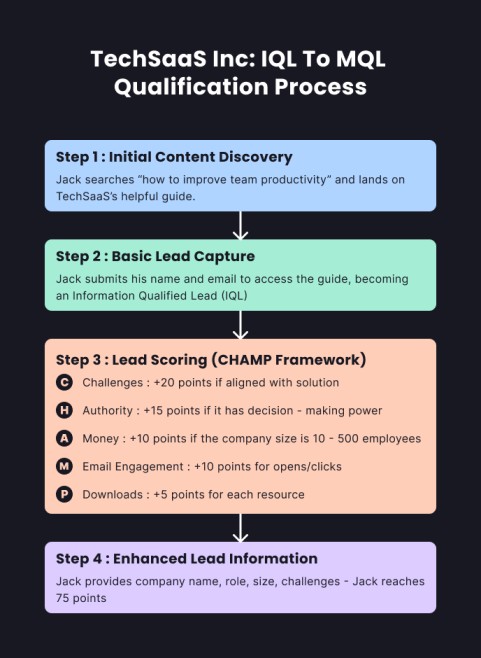
Example #2: VP of Operations Needs Consulting Services
ConsultPro provides management consulting services to mid-market companies. They’ve implemented a comprehensive lead qualification process to convert Sales Accepted Leads (SALs) to Sales Qualified Leads (SQLs).
One such lead is Michael, a VP of Operations at a manufacturing company with 300 employees. Michael has downloaded several whitepapers on operational efficiency, attended a webinar, and visited the pricing page multiple times. Moreover, he’s sent an inquiry about their services. Before making contact, ConsultPro’s sales team conducts thorough research about him and the company.
They used MEDDIC as their qualification framework and eventually crafted questions that would help their sales rep learn more about their needs:
- Metrics: The sales rep needs to understand what KPIs Michael is trying to improve.
- Economic Buyer: Who controls the budget for consulting services?
- Decision Criteria: What factors will influence the purchase decision?
- Decision Process: What steps must be taken to approve the purchase?
- Identify Pain: What specific operational challenges are they facing?
- Champion: Is Michael (or someone else) an internal advocate?
With their lead scoring system, Michael exceeds ConsultPro’s 100-point threshold for SAL qualification, and a sales representative schedules a discovery call with him to understand their needs.
Soon after, one of ConsultPro’s account executives develops a tailored proposal addressing Michael’s specific challenges, timeline, and budget parameters.
Michaels’s reception of the presentation was good, and he is willing to arrange a meeting with the decision makers he identified during the qualification process. This moves him firmly into the SQL category and positions ConsultPro for a successful close.
Start Qualifying Your Leads!
Now you’re ready to kickstart an entire lead qualification process. Some final thoughts: take advantage of tools to automate it.
Qualifying leads may be simple, but doing it for hundreds, if not thousands, can easily exhaust your resources. Navigating an ever-changing landscape is always a good quality of a sales professional.

